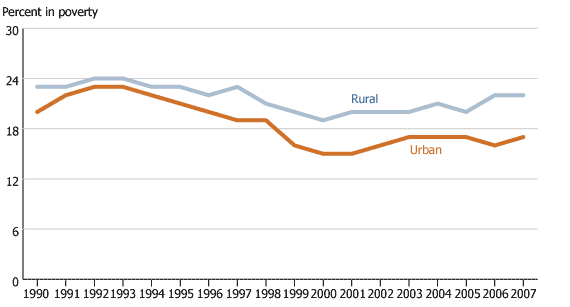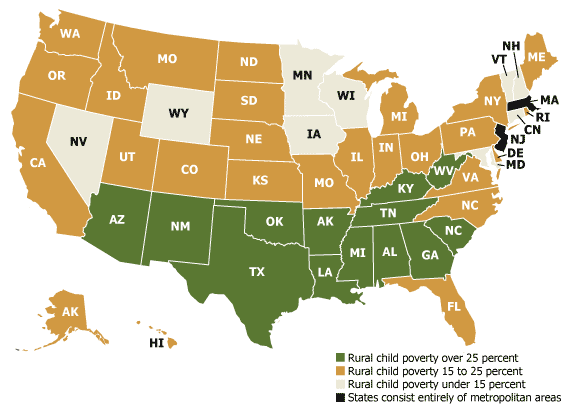
Poverty Is a Persistent Reality for Many Rural Children in U.S.
(September 2009) Although child poverty conjures up an urban image for most Americans, one-fifth of children in poverty live in rural areas. Poverty rates are higher for rural than for urban children, and the gap has increased in recent years. Rural children are more likely than urban children to live in extreme poverty—at less than one-half the poverty threshold (under $11,000 for a family of four in 2007). And, while many people move in and out of poverty as their circumstances change, spells of poverty last longer for rural children. They are the “forgotten fifth” of poor children because most programs and policies to help the poor are focused on urban areas.
Rural children have had higher poverty rates for decades.1 In 1970, the poverty rate was 20 percent for rural children compared with 12 percent for urban children. Although the gap narrowed in the 1970s and 1980s, the rates have diverged since the early 1990s (see figure). The rise of child poverty in rural America is consistent with the growing income gap between urban and rural families over this same period.2
Poverty Rates Declined More for Urban Than for Rural Children in U.S., 1990-2007

Source: William P. O’Hare, The Forgotten Fifth: Child Poverty in Rural America (2009).
Majority of Rural Poor Children Are White
Rural poor children are more likely than the urban poor to be white. More than one-half (57 percent) of all poor rural children are non-Hispanic white, compared with just over one-fourth (28 percent) of poor urban children. Twenty-one percent of poor rural children are black, 15 percent are Hispanic, and 4 percent are American Indian or Alaska Native. Asians, who are highly urban, account for very few of the rural poor. There is no ethnic majority among poor urban children: 35 percent are Hispanic, 30 percent are black, and just 1 percent are American Indian/Alaska Native.
Rural Poverty Concentrated by Region
The national trends mask enormous variations across the country. The rural child poverty rate ranges from a low of 8 percent in Connecticut to a high of 35 percent in Mississippi.3 More than one-fourth of the children are poor in 12 states that stretch in a clear swathe across much of the South, into Appalachia, and the Southwest (see map). The states with the lowest rural child poverty rates are clustered in New England, the upper Midwest, and the middle Atlantic, plus Wyoming and Nevada.
Rural Child Poverty in U.S. States, 2007

Source: William P. O’Hare, The Forgotten Fifth: Child Poverty in Rural America (2009).
These regional variations also have a marked racial and ethnic overlay. The vast majority of rural poor black children live in the South—a legacy of slavery, racial oppression, and economic marginalization. Poor rural Hispanic children are heavily concentrated in the South and the West. Appalachia, which stretches from southern New York to northwest Mississippi, has many pockets of poverty, but most of the area’s poor are non-Hispanic white. Poverty among rural American Indian children is concentrated in a small number of reservations in the Southwest and Northern Plains states.
Rural Poverty Deeper, More Persistent
Because rural children are also more likely to live in deep poverty and for longer spells, their families often grapple with severe economic problems. The poorest families benefited the least from the economic boom in the late 1990s, and the major reform of the welfare system during those years may have exacerbated their plight.4 An income difference of a few thousand dollars a year can have a major effect on child well-being.5 Small differences in expenditures in early childhood can also have implications for well-being in adulthood.6
Poor children living in rural America face significant challenges just as their urban counterparts do, but many problems are exacerbated by their isolation and limited access to support services that are common in urban areas. Rural parents tend to have less education and are more likely to be underemployed than urban parents, putting their children at higher risk of becoming poor. A smaller percentage of rural children than urban children live in married-couple families, and have a higher risk of poverty. And rural poverty can be especially persistent because, in addition to a scarcity of jobs and physical and social isolation in rural areas, many rural residents shun government assistance out of a high value placed on self-reliance and the stigma that often goes with welfare.
William P. O’Hare is visiting senior fellow at the Carsey Institute, University of New Hampshire. This article was adapted from William P. O’Hare, The Forgotten Fifth: Child Poverty in Rural America (Durham, NH: Carsey Institute, 2009).
References
- Cynthia M. Duncan, Rural Poverty in America (Westport, CT: Auburn House, 1992); and Economic Research Service, “Rural Employment at a Glance,” Bulletin no. 21 (Washington, DC: U.S. Department of Agriculture, Economic Information Research, 2006).
- Sarah Savage, “Children in Central Cities and Rural Communities Experience High Rates of Poverty,” Fact Sheet no. 12 (Durham, NH: Carsey Institute, University of New Hampshire, 2008).
- Rebecca Blank, “Improving the Safety Net for Single Mothers Who Face Serious Barriers to Work,” The Future of Children 17, no. 2 (2007): 183–97; and Greg J. Duncan et al., “How Much Does Childhood Poverty Affect the Life Chances of Children?” American Sociological Review 63, no. 3 (1998): 406–23.
- Greg J. Duncan and Ariel Kalil, “Economic Costs of Early Childhood Poverty,” paper presented at the Population Association of America annual meetings, New Orleans, April 17-20, 2008.
